MAR015-2: Literature Review on Culture's Influence on Motivation
VerifiedAdded on 2023/06/13
|9
|2294
|137
Literature Review
AI Summary
This literature review examines the influence of organizational culture on employee motivation, drawing upon various studies and theories. It highlights the importance of a positive work environment, open communication, and management styles in fostering employee engagement and productivity. The review also addresses the challenges of implementing cultural changes and the need for managers to understand and address employee concerns. Motivational theories and their application in different organizational contexts are explored, emphasizing the impact on employee performance and overall company success. The document concludes that a positive organizational culture is crucial for achieving company objectives and enhancing employee development. Desklib offers a wealth of resources, including solved assignments and past papers, to aid students in their studies.
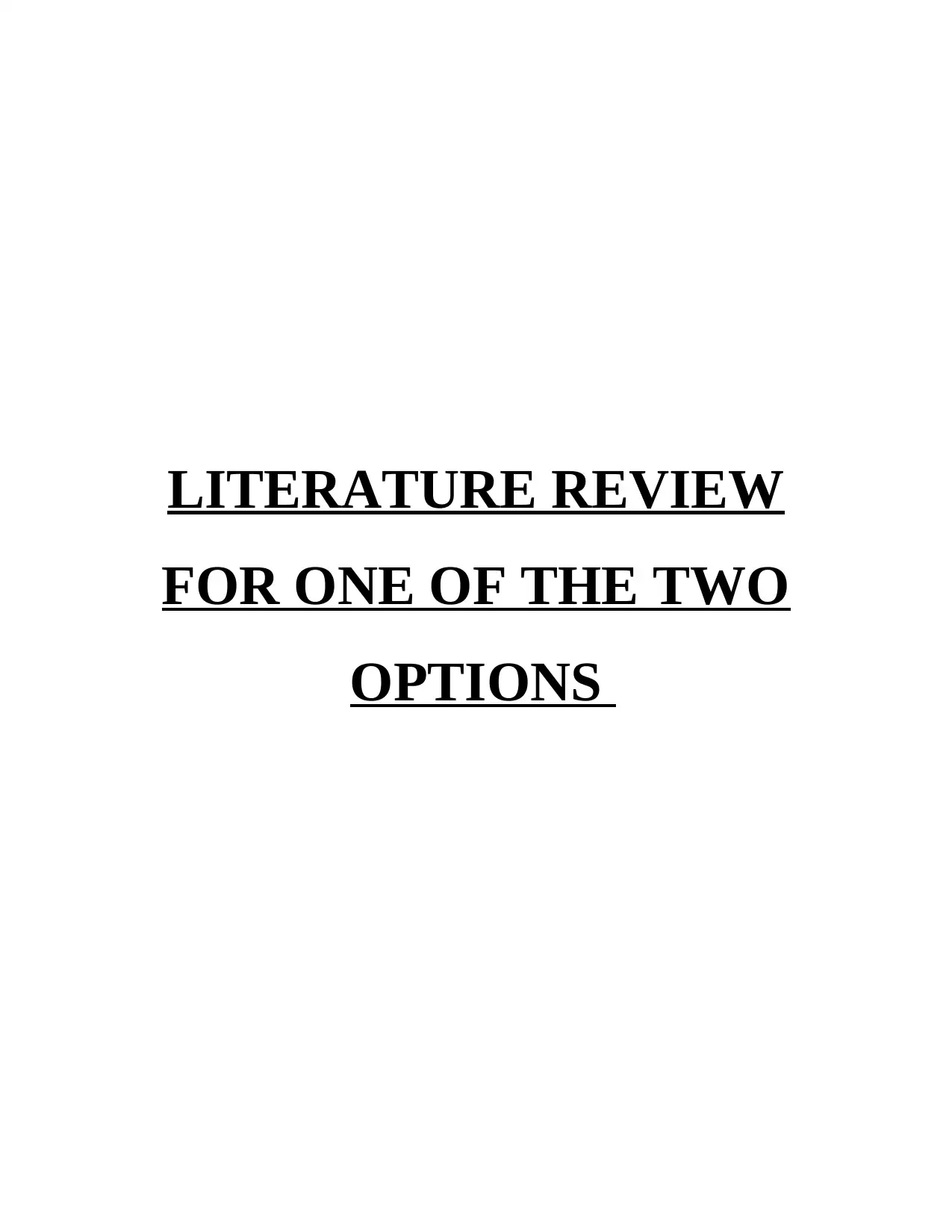
LITERATURE REVIEW
FOR ONE OF THE TWO
OPTIONS
FOR ONE OF THE TWO
OPTIONS
Paraphrase This Document
Need a fresh take? Get an instant paraphrase of this document with our AI Paraphraser
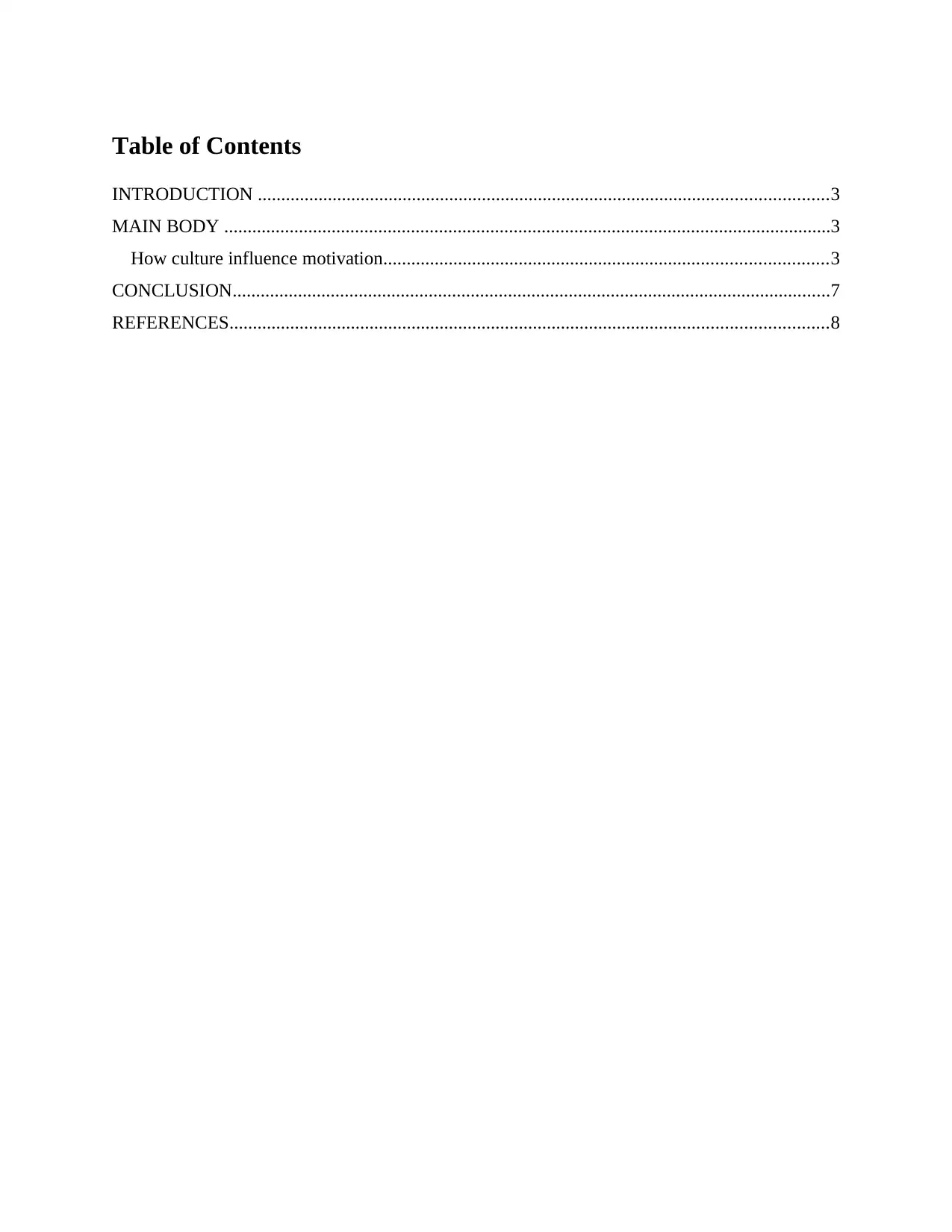
Table of Contents
INTRODUCTION ..........................................................................................................................3
MAIN BODY ..................................................................................................................................3
How culture influence motivation...............................................................................................3
CONCLUSION................................................................................................................................7
REFERENCES................................................................................................................................8
INTRODUCTION ..........................................................................................................................3
MAIN BODY ..................................................................................................................................3
How culture influence motivation...............................................................................................3
CONCLUSION................................................................................................................................7
REFERENCES................................................................................................................................8

INTRODUCTION
The company should have favourable organizational culture as it helps the employees to
work towards achieving the goals and objectives of the organization. It helps in building
effective communication among the employees. Positive working environment enable the
employee to put their efforts in performing the task to meet the goals of the company. The report
is based on the literature review which highlights that how the culture influence motivation of
employees in the company.
MAIN BODY
How culture influence motivation
As per the view given by the Goetz and Schork (2018), motivation is a professional technique
that involve boosting up the morale of the employee to enhance and maximize productivity and
efficiency as a professional. Motivation involve inspiring employees ion the organisation to put
extra efforts to achieve better level of efficiency and proficiency as a professional and employee
in the organisation. This whole technique guide the employee to process the initiates, guides and
also to maintain the goal oriented behaviour. The term motivation further involve biological,
emotional, social and cognitive forces that may support the employee to work in the best of the
capacity. This entire process is more like supporting the human resource to explore the bets of its
capacity and to further maximise the career goals. Motivation is also segregated into the three
different types extrinsic, intrinsic and family related factors that channel to the mindset of the
employee to explore more. Along with that teher are various other form of motivation also
spotted which involve achievement oriented motivation, affiliation motivation, competence
motivation, power motivation, attitude motivation and fear motivation. All these are the various
types of motivation feature that support and boost te individual morale of the human resource in
the organization. All these various types and kinds of motivation feature support and direct the
employee to work in the best of their own capacity. Increased productivity of employee is one of
the most significant factor or element that may lead by the motivation.
According to the Roscoe, and et.al, ( 2019) the culture of the organization is defined as
the shared beliefs, values, assumptions and the way employees communicate and interact with
each other within the company. As per the Hald, and et.al, (2021) the companies should have
The company should have favourable organizational culture as it helps the employees to
work towards achieving the goals and objectives of the organization. It helps in building
effective communication among the employees. Positive working environment enable the
employee to put their efforts in performing the task to meet the goals of the company. The report
is based on the literature review which highlights that how the culture influence motivation of
employees in the company.
MAIN BODY
How culture influence motivation
As per the view given by the Goetz and Schork (2018), motivation is a professional technique
that involve boosting up the morale of the employee to enhance and maximize productivity and
efficiency as a professional. Motivation involve inspiring employees ion the organisation to put
extra efforts to achieve better level of efficiency and proficiency as a professional and employee
in the organisation. This whole technique guide the employee to process the initiates, guides and
also to maintain the goal oriented behaviour. The term motivation further involve biological,
emotional, social and cognitive forces that may support the employee to work in the best of the
capacity. This entire process is more like supporting the human resource to explore the bets of its
capacity and to further maximise the career goals. Motivation is also segregated into the three
different types extrinsic, intrinsic and family related factors that channel to the mindset of the
employee to explore more. Along with that teher are various other form of motivation also
spotted which involve achievement oriented motivation, affiliation motivation, competence
motivation, power motivation, attitude motivation and fear motivation. All these are the various
types of motivation feature that support and boost te individual morale of the human resource in
the organization. All these various types and kinds of motivation feature support and direct the
employee to work in the best of their own capacity. Increased productivity of employee is one of
the most significant factor or element that may lead by the motivation.
According to the Roscoe, and et.al, ( 2019) the culture of the organization is defined as
the shared beliefs, values, assumptions and the way employees communicate and interact with
each other within the company. As per the Hald, and et.al, (2021) the companies should have
⊘ This is a preview!⊘
Do you want full access?
Subscribe today to unlock all pages.

Trusted by 1+ million students worldwide
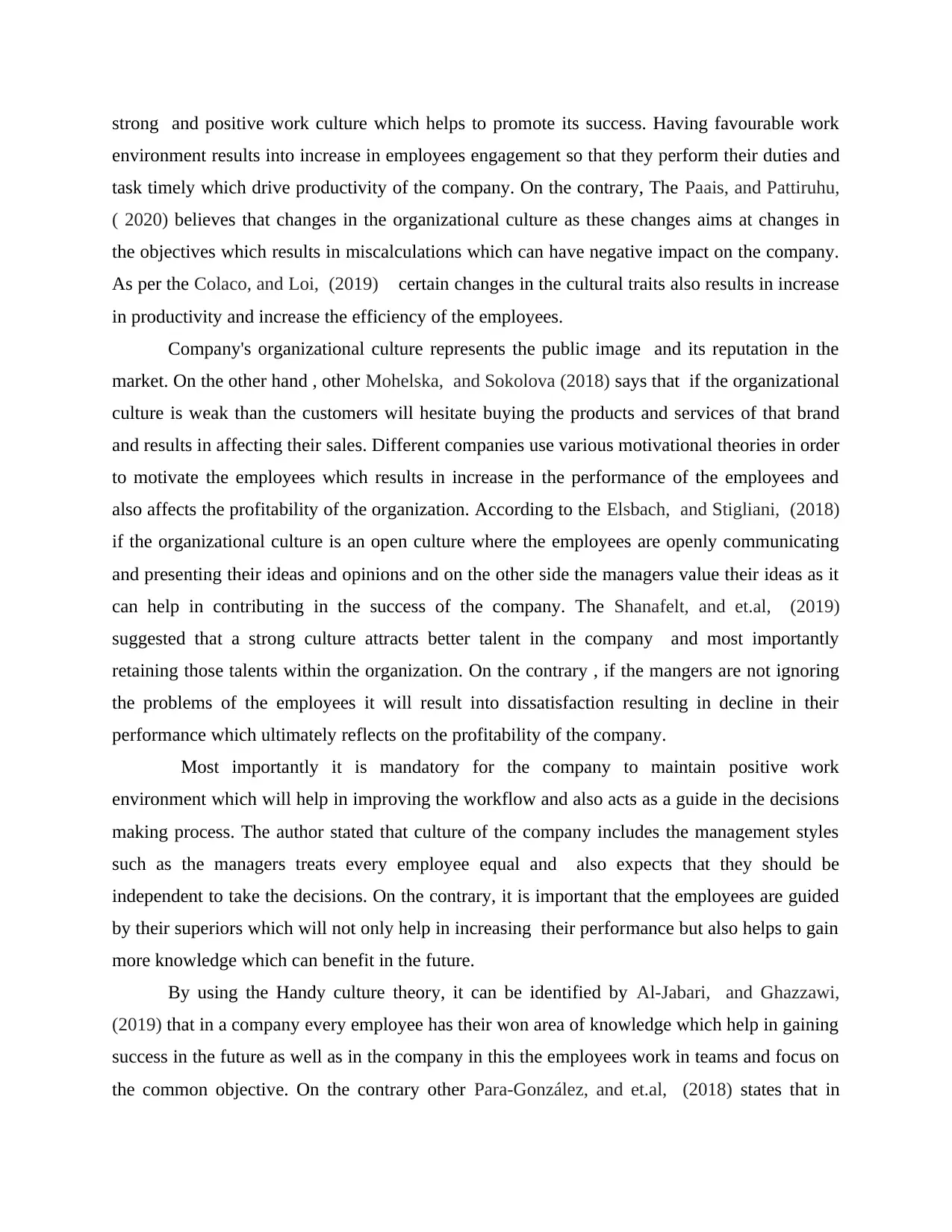
strong and positive work culture which helps to promote its success. Having favourable work
environment results into increase in employees engagement so that they perform their duties and
task timely which drive productivity of the company. On the contrary, The Paais, and Pattiruhu,
( 2020) believes that changes in the organizational culture as these changes aims at changes in
the objectives which results in miscalculations which can have negative impact on the company.
As per the Colaco, and Loi, (2019) certain changes in the cultural traits also results in increase
in productivity and increase the efficiency of the employees.
Company's organizational culture represents the public image and its reputation in the
market. On the other hand , other Mohelska, and Sokolova (2018) says that if the organizational
culture is weak than the customers will hesitate buying the products and services of that brand
and results in affecting their sales. Different companies use various motivational theories in order
to motivate the employees which results in increase in the performance of the employees and
also affects the profitability of the organization. According to the Elsbach, and Stigliani, (2018)
if the organizational culture is an open culture where the employees are openly communicating
and presenting their ideas and opinions and on the other side the managers value their ideas as it
can help in contributing in the success of the company. The Shanafelt, and et.al, (2019)
suggested that a strong culture attracts better talent in the company and most importantly
retaining those talents within the organization. On the contrary , if the mangers are not ignoring
the problems of the employees it will result into dissatisfaction resulting in decline in their
performance which ultimately reflects on the profitability of the company.
Most importantly it is mandatory for the company to maintain positive work
environment which will help in improving the workflow and also acts as a guide in the decisions
making process. The author stated that culture of the company includes the management styles
such as the managers treats every employee equal and also expects that they should be
independent to take the decisions. On the contrary, it is important that the employees are guided
by their superiors which will not only help in increasing their performance but also helps to gain
more knowledge which can benefit in the future.
By using the Handy culture theory, it can be identified by Al-Jabari, and Ghazzawi,
(2019) that in a company every employee has their won area of knowledge which help in gaining
success in the future as well as in the company in this the employees work in teams and focus on
the common objective. On the contrary other Para-González, and et.al, (2018) states that in
environment results into increase in employees engagement so that they perform their duties and
task timely which drive productivity of the company. On the contrary, The Paais, and Pattiruhu,
( 2020) believes that changes in the organizational culture as these changes aims at changes in
the objectives which results in miscalculations which can have negative impact on the company.
As per the Colaco, and Loi, (2019) certain changes in the cultural traits also results in increase
in productivity and increase the efficiency of the employees.
Company's organizational culture represents the public image and its reputation in the
market. On the other hand , other Mohelska, and Sokolova (2018) says that if the organizational
culture is weak than the customers will hesitate buying the products and services of that brand
and results in affecting their sales. Different companies use various motivational theories in order
to motivate the employees which results in increase in the performance of the employees and
also affects the profitability of the organization. According to the Elsbach, and Stigliani, (2018)
if the organizational culture is an open culture where the employees are openly communicating
and presenting their ideas and opinions and on the other side the managers value their ideas as it
can help in contributing in the success of the company. The Shanafelt, and et.al, (2019)
suggested that a strong culture attracts better talent in the company and most importantly
retaining those talents within the organization. On the contrary , if the mangers are not ignoring
the problems of the employees it will result into dissatisfaction resulting in decline in their
performance which ultimately reflects on the profitability of the company.
Most importantly it is mandatory for the company to maintain positive work
environment which will help in improving the workflow and also acts as a guide in the decisions
making process. The author stated that culture of the company includes the management styles
such as the managers treats every employee equal and also expects that they should be
independent to take the decisions. On the contrary, it is important that the employees are guided
by their superiors which will not only help in increasing their performance but also helps to gain
more knowledge which can benefit in the future.
By using the Handy culture theory, it can be identified by Al-Jabari, and Ghazzawi,
(2019) that in a company every employee has their won area of knowledge which help in gaining
success in the future as well as in the company in this the employees work in teams and focus on
the common objective. On the contrary other Para-González, and et.al, (2018) states that in
Paraphrase This Document
Need a fresh take? Get an instant paraphrase of this document with our AI Paraphraser

many companies the power of decision-making vests in the hands of few people, and they also
enjoy special privileges which demotivate other employees which affects their performance.
Many companies have the culture of delegating the roles and responsibilities to the employees
having specialized knowledge. In this type of positive cultural environment, employees use their
knowledge and skills and always willing to accept the challenge which not only help in
increasing the productivity but also enhance their performance and personal development of the
company.
According to the Groysberg, and et.al, (2018), the company uses various motivational
theories in order to encourage the employees which helps in evaluating their preferences and
needs and then after analysing implementing those strategies that positively affect their
performance and also increase the productivity of the company as well. On the other hand it is
observed that many employees hesitate in communicating and sharing their problems with their
managers and in order to overcome this challenge the managers can communicate with those
employees and provide suggestions which can helps to build the relation between the manger and
employees and in future they can easily interact and share their problems related to the tasks
assigned.
The Diamantidis, and Chatzoglou, (2019) also stated that having a positive and strong
organizational culture the company has to observe the behaviour of an individual as they come
form different backgrounds which will also help in understanding that person . On the other hand
, the Faupel, and Süß, (2019) believes that in order to make changes in the working
environment of the company , the management should not ignore the main objective of the
company which is priority. It has been observed by the Men, . and Yue, (2019). that the
management reward the employees for their efforts and performance when they accomplish the
task in a given time period which also acts a motivator in increasing their performance but on the
contrary it has been observed that rather getting motivated many employees have dissatisfaction.
Every company has a vision to accomplish there objectives and also to expand its brand globally
and for achieving this the company should focus on conducting training and development
programmes which help ion increasing their area of knowledge and capabilities so that they can
perform their task more effectively.
enjoy special privileges which demotivate other employees which affects their performance.
Many companies have the culture of delegating the roles and responsibilities to the employees
having specialized knowledge. In this type of positive cultural environment, employees use their
knowledge and skills and always willing to accept the challenge which not only help in
increasing the productivity but also enhance their performance and personal development of the
company.
According to the Groysberg, and et.al, (2018), the company uses various motivational
theories in order to encourage the employees which helps in evaluating their preferences and
needs and then after analysing implementing those strategies that positively affect their
performance and also increase the productivity of the company as well. On the other hand it is
observed that many employees hesitate in communicating and sharing their problems with their
managers and in order to overcome this challenge the managers can communicate with those
employees and provide suggestions which can helps to build the relation between the manger and
employees and in future they can easily interact and share their problems related to the tasks
assigned.
The Diamantidis, and Chatzoglou, (2019) also stated that having a positive and strong
organizational culture the company has to observe the behaviour of an individual as they come
form different backgrounds which will also help in understanding that person . On the other hand
, the Faupel, and Süß, (2019) believes that in order to make changes in the working
environment of the company , the management should not ignore the main objective of the
company which is priority. It has been observed by the Men, . and Yue, (2019). that the
management reward the employees for their efforts and performance when they accomplish the
task in a given time period which also acts a motivator in increasing their performance but on the
contrary it has been observed that rather getting motivated many employees have dissatisfaction.
Every company has a vision to accomplish there objectives and also to expand its brand globally
and for achieving this the company should focus on conducting training and development
programmes which help ion increasing their area of knowledge and capabilities so that they can
perform their task more effectively.

In order to maintain its position and compete in the market , the company has to make
various modifications and changes within the company which also involves the change in the
working environment and for this the management has to examine various factors in order to
implement such changes within the company. According to the Mohapatra, and Sundaray, (2018)
when any such change is implemented most of the employees resist those changes and on the
other side some supports these changes in the culture which is a big challenge for the managers
to convey the benefits of such changes which is mandatory for effective functioning of the
organisation. It is also believed that to maintain positive culture in the company is not the duty
of the managers but also of the employees as it will result into effective communication among
other team members, and they will work more effectively in accomplishing the objectives of the
company as well as personal development of the employees .
The Kim, and Beehr, (2020) supports that the culture of the organisation influences and
motivates the employees which positively affects their performance but on the other hand, the
Driskill, (2018) states that several times employees do not adjust in the changes made and resist
those changes which becomes difficult for the company to manage and understand the
employees that results in decline in their performance effecting the objectives of the
organisation.
various modifications and changes within the company which also involves the change in the
working environment and for this the management has to examine various factors in order to
implement such changes within the company. According to the Mohapatra, and Sundaray, (2018)
when any such change is implemented most of the employees resist those changes and on the
other side some supports these changes in the culture which is a big challenge for the managers
to convey the benefits of such changes which is mandatory for effective functioning of the
organisation. It is also believed that to maintain positive culture in the company is not the duty
of the managers but also of the employees as it will result into effective communication among
other team members, and they will work more effectively in accomplishing the objectives of the
company as well as personal development of the employees .
The Kim, and Beehr, (2020) supports that the culture of the organisation influences and
motivates the employees which positively affects their performance but on the other hand, the
Driskill, (2018) states that several times employees do not adjust in the changes made and resist
those changes which becomes difficult for the company to manage and understand the
employees that results in decline in their performance effecting the objectives of the
organisation.
⊘ This is a preview!⊘
Do you want full access?
Subscribe today to unlock all pages.

Trusted by 1+ million students worldwide
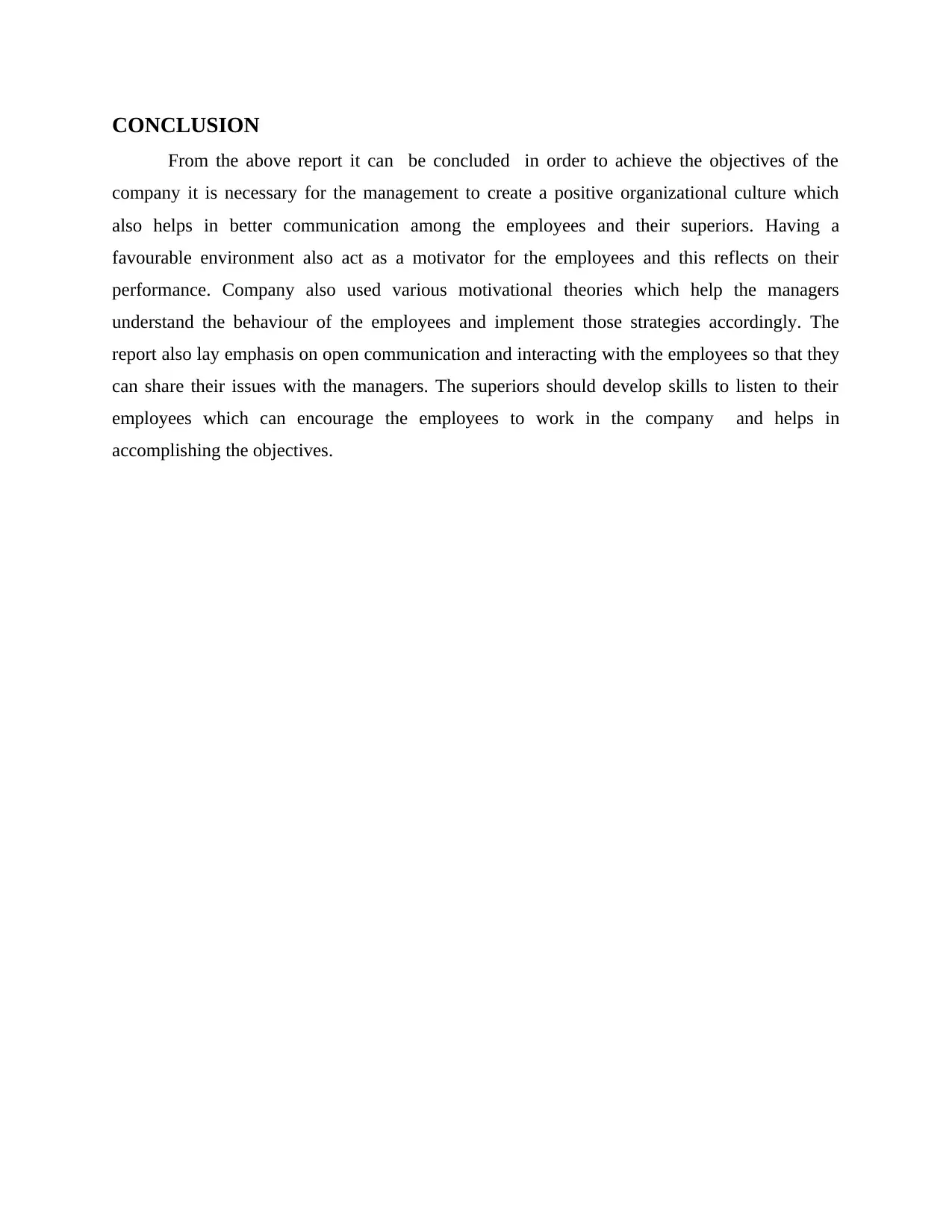
CONCLUSION
From the above report it can be concluded in order to achieve the objectives of the
company it is necessary for the management to create a positive organizational culture which
also helps in better communication among the employees and their superiors. Having a
favourable environment also act as a motivator for the employees and this reflects on their
performance. Company also used various motivational theories which help the managers
understand the behaviour of the employees and implement those strategies accordingly. The
report also lay emphasis on open communication and interacting with the employees so that they
can share their issues with the managers. The superiors should develop skills to listen to their
employees which can encourage the employees to work in the company and helps in
accomplishing the objectives.
From the above report it can be concluded in order to achieve the objectives of the
company it is necessary for the management to create a positive organizational culture which
also helps in better communication among the employees and their superiors. Having a
favourable environment also act as a motivator for the employees and this reflects on their
performance. Company also used various motivational theories which help the managers
understand the behaviour of the employees and implement those strategies accordingly. The
report also lay emphasis on open communication and interacting with the employees so that they
can share their issues with the managers. The superiors should develop skills to listen to their
employees which can encourage the employees to work in the company and helps in
accomplishing the objectives.
Paraphrase This Document
Need a fresh take? Get an instant paraphrase of this document with our AI Paraphraser
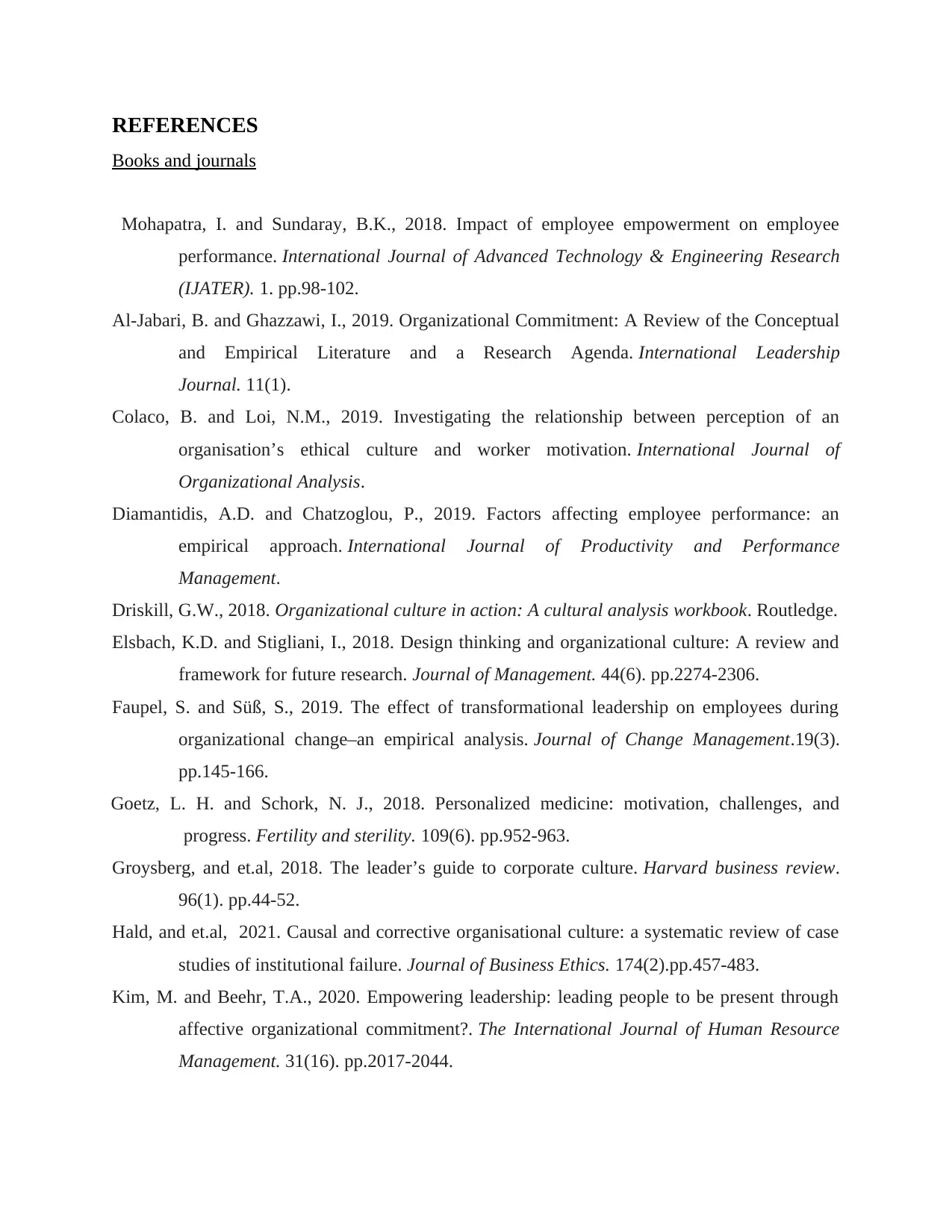
REFERENCES
Books and journals
Mohapatra, I. and Sundaray, B.K., 2018. Impact of employee empowerment on employee
performance. International Journal of Advanced Technology & Engineering Research
(IJATER). 1. pp.98-102.
Al-Jabari, B. and Ghazzawi, I., 2019. Organizational Commitment: A Review of the Conceptual
and Empirical Literature and a Research Agenda. International Leadership
Journal. 11(1).
Colaco, B. and Loi, N.M., 2019. Investigating the relationship between perception of an
organisation’s ethical culture and worker motivation. International Journal of
Organizational Analysis.
Diamantidis, A.D. and Chatzoglou, P., 2019. Factors affecting employee performance: an
empirical approach. International Journal of Productivity and Performance
Management.
Driskill, G.W., 2018. Organizational culture in action: A cultural analysis workbook. Routledge.
Elsbach, K.D. and Stigliani, I., 2018. Design thinking and organizational culture: A review and
framework for future research. Journal of Management. 44(6). pp.2274-2306.
Faupel, S. and Süß, S., 2019. The effect of transformational leadership on employees during
organizational change–an empirical analysis. Journal of Change Management.19(3).
pp.145-166.
Goetz, L. H. and Schork, N. J., 2018. Personalized medicine: motivation, challenges, and
progress. Fertility and sterility. 109(6). pp.952-963.
Groysberg, and et.al, 2018. The leader’s guide to corporate culture. Harvard business review.
96(1). pp.44-52.
Hald, and et.al, 2021. Causal and corrective organisational culture: a systematic review of case
studies of institutional failure. Journal of Business Ethics. 174(2).pp.457-483.
Kim, M. and Beehr, T.A., 2020. Empowering leadership: leading people to be present through
affective organizational commitment?. The International Journal of Human Resource
Management. 31(16). pp.2017-2044.
Books and journals
Mohapatra, I. and Sundaray, B.K., 2018. Impact of employee empowerment on employee
performance. International Journal of Advanced Technology & Engineering Research
(IJATER). 1. pp.98-102.
Al-Jabari, B. and Ghazzawi, I., 2019. Organizational Commitment: A Review of the Conceptual
and Empirical Literature and a Research Agenda. International Leadership
Journal. 11(1).
Colaco, B. and Loi, N.M., 2019. Investigating the relationship between perception of an
organisation’s ethical culture and worker motivation. International Journal of
Organizational Analysis.
Diamantidis, A.D. and Chatzoglou, P., 2019. Factors affecting employee performance: an
empirical approach. International Journal of Productivity and Performance
Management.
Driskill, G.W., 2018. Organizational culture in action: A cultural analysis workbook. Routledge.
Elsbach, K.D. and Stigliani, I., 2018. Design thinking and organizational culture: A review and
framework for future research. Journal of Management. 44(6). pp.2274-2306.
Faupel, S. and Süß, S., 2019. The effect of transformational leadership on employees during
organizational change–an empirical analysis. Journal of Change Management.19(3).
pp.145-166.
Goetz, L. H. and Schork, N. J., 2018. Personalized medicine: motivation, challenges, and
progress. Fertility and sterility. 109(6). pp.952-963.
Groysberg, and et.al, 2018. The leader’s guide to corporate culture. Harvard business review.
96(1). pp.44-52.
Hald, and et.al, 2021. Causal and corrective organisational culture: a systematic review of case
studies of institutional failure. Journal of Business Ethics. 174(2).pp.457-483.
Kim, M. and Beehr, T.A., 2020. Empowering leadership: leading people to be present through
affective organizational commitment?. The International Journal of Human Resource
Management. 31(16). pp.2017-2044.
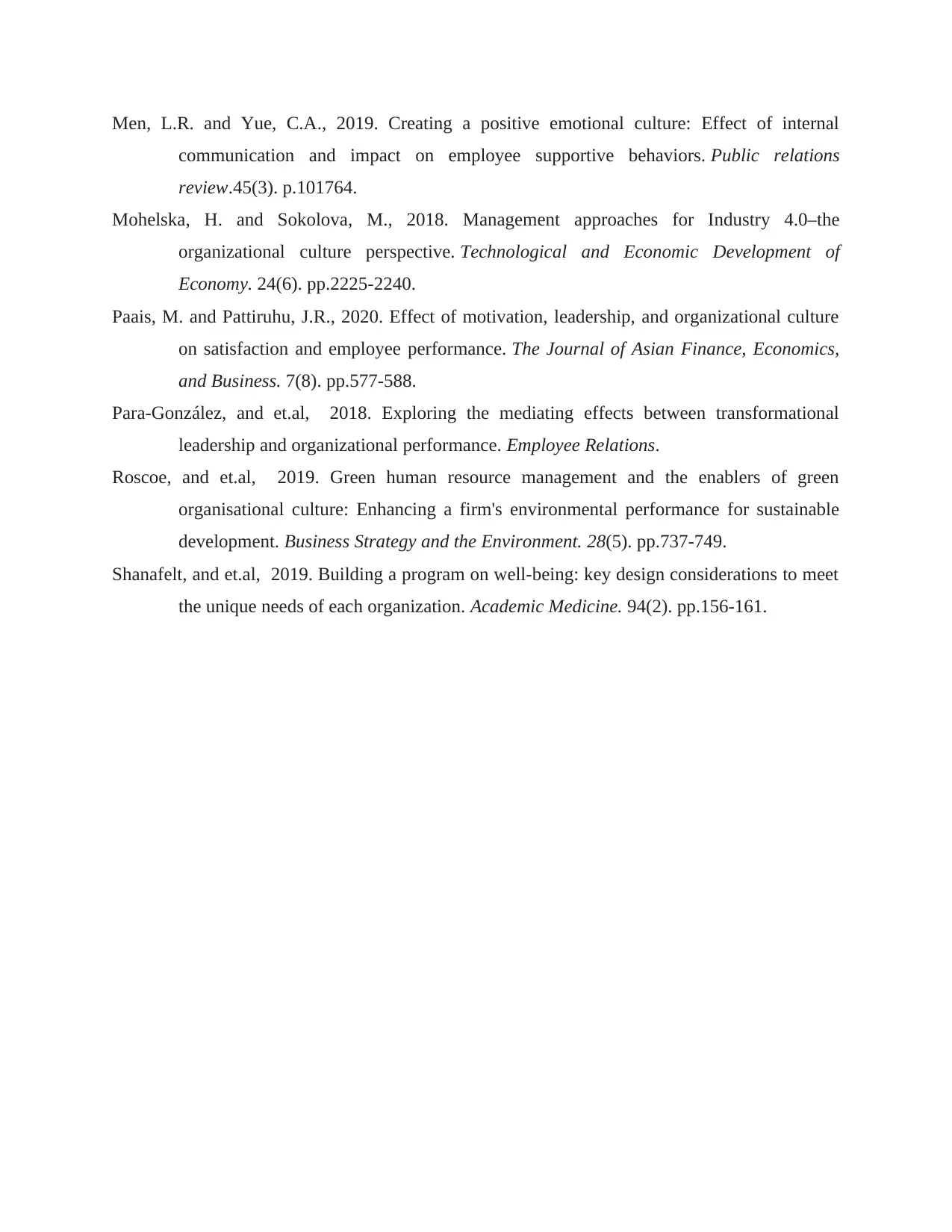
Men, L.R. and Yue, C.A., 2019. Creating a positive emotional culture: Effect of internal
communication and impact on employee supportive behaviors. Public relations
review.45(3). p.101764.
Mohelska, H. and Sokolova, M., 2018. Management approaches for Industry 4.0–the
organizational culture perspective. Technological and Economic Development of
Economy. 24(6). pp.2225-2240.
Paais, M. and Pattiruhu, J.R., 2020. Effect of motivation, leadership, and organizational culture
on satisfaction and employee performance. The Journal of Asian Finance, Economics,
and Business. 7(8). pp.577-588.
Para-González, and et.al, 2018. Exploring the mediating effects between transformational
leadership and organizational performance. Employee Relations.
Roscoe, and et.al, 2019. Green human resource management and the enablers of green
organisational culture: Enhancing a firm's environmental performance for sustainable
development. Business Strategy and the Environment. 28(5). pp.737-749.
Shanafelt, and et.al, 2019. Building a program on well-being: key design considerations to meet
the unique needs of each organization. Academic Medicine. 94(2). pp.156-161.
communication and impact on employee supportive behaviors. Public relations
review.45(3). p.101764.
Mohelska, H. and Sokolova, M., 2018. Management approaches for Industry 4.0–the
organizational culture perspective. Technological and Economic Development of
Economy. 24(6). pp.2225-2240.
Paais, M. and Pattiruhu, J.R., 2020. Effect of motivation, leadership, and organizational culture
on satisfaction and employee performance. The Journal of Asian Finance, Economics,
and Business. 7(8). pp.577-588.
Para-González, and et.al, 2018. Exploring the mediating effects between transformational
leadership and organizational performance. Employee Relations.
Roscoe, and et.al, 2019. Green human resource management and the enablers of green
organisational culture: Enhancing a firm's environmental performance for sustainable
development. Business Strategy and the Environment. 28(5). pp.737-749.
Shanafelt, and et.al, 2019. Building a program on well-being: key design considerations to meet
the unique needs of each organization. Academic Medicine. 94(2). pp.156-161.
⊘ This is a preview!⊘
Do you want full access?
Subscribe today to unlock all pages.

Trusted by 1+ million students worldwide
1 out of 9
Related Documents
Your All-in-One AI-Powered Toolkit for Academic Success.
+13062052269
info@desklib.com
Available 24*7 on WhatsApp / Email
![[object Object]](/_next/static/media/star-bottom.7253800d.svg)
Unlock your academic potential
Copyright © 2020–2025 A2Z Services. All Rights Reserved. Developed and managed by ZUCOL.



